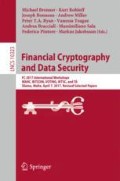Abstract
Bitcoin’s core innovation is its solution to double-spending, called Nakamoto consensus. This provides a probabilistic guarantee that transactions will not be reversed or redirected, presuming that it is improbable for an attacker to obtain a majority of mining power in the network. However, this guarantee can be undermined when miners are assumed to be rational, and hence venal. Accordingly, we present the whale attack, in which a minority attacker increases her chances of double-spending by incentivizing miners to subvert the consensus protocol and to collude via whale transactions, which are bribery transactions carrying anomalously large fees. We analyze the expected cost to carry out the attack with success probability 1, and simulate the attack under realistic system parameters. Our results show that double-spend attacks, conventionally thought to be impractical for minority attackers, can actually be financially feasible and worthwhile under the whale attack. Perhaps more importantly, this work demonstrates that rationality should not underestimated when evaluating the security of cryptocurrencies.
Access this chapter
Tax calculation will be finalised at checkout
Purchases are for personal use only
Notes
- 1.
cc455ae816e6cdafdb58d54e35d4f46d860047458eacf1c7405dc634631c570d.
References
Nakamoto, S.: Bitcoin: a peer-to-peer electronic cash system (2008)
Garay, J., Kiayias, A., Leonardos, N.: The bitcoin backbone protocol: analysis and applications. In: Oswald, E., Fischlin, M. (eds.) EUROCRYPT 2015. LNCS, vol. 9057, pp. 281–310. Springer, Heidelberg (2015). https://doi.org/10.1007/978-3-662-46803-6_10
Rosenfeld, M.: Analysis of bitcoin pooled mining reward systems. arXiv preprint. arXiv:1112.4980 (2011)
Eyal, I.: The miner’s dilemma. In: 2015 IEEE Symposium on Security and Privacy, pp. 89–103. IEEE (2015)
Eyal, I., Sirer, E.G.: Majority is not enough: bitcoin mining is vulnerable. In: Christin, N., Safavi-Naini, R. (eds.) FC 2014. LNCS, vol. 8437, pp. 436–454. Springer, Heidelberg (2014). https://doi.org/10.1007/978-3-662-45472-5_28
Nayak, K., Kumar, S., Miller, A., Shi, E.: Stubborn mining: generalizing selfish mining and combining with an eclipse attack. In: 2016 IEEE European Symposium on Security and Privacy (EuroS&P), pp. 305–320. IEEE (2016)
Sapirshtein, A., Sompolinsky, Y., Zohar, A.: Optimal selfish mining strategies in bitcoin. arXiv preprint. arXiv:1507.06183 (2015)
Bonneau, J.: Why buy when you can rent? Bribery attacks on bitcoin-style consensus. In: Clark, J., Meiklejohn, S., Ryan, P.Y.A., Wallach, D., Brenner, M., Rohloff, K. (eds.) FC 2016. LNCS, vol. 9604, pp. 19–26. Springer, Heidelberg (2016). https://doi.org/10.1007/978-3-662-53357-4_2
Teutsch, J., Jain, S., Saxena, P.: When cryptocurrencies mine their own business. In: Grossklags, J., Preneel, B. (eds.) FC 2016. LNCS, vol. 9603, pp. 499–514. Springer, Heidelberg (2017). https://doi.org/10.1007/978-3-662-54970-4_29
Möser, M., Böhme, R.: Trends, tips, tolls: a longitudinal study of bitcoin transaction fees. In: Brenner, M., Christin, N., Johnson, B., Rohloff, K. (eds.) FC 2015. LNCS, vol. 8976, pp. 19–33. Springer, Heidelberg (2015). https://doi.org/10.1007/978-3-662-48051-9_2
Kroll, J.A., Davey, I.C., Felten, E.W.: The economics of bitcoin mining, or bitcoin in the presence of adversaries. In: Proceedings of WEIS, vol. 2013. Citeseer (2013)
Houy, N.: The economics of bitcoin transaction fees. In: GATE WP, vol. 1407 (2014)
Kaskaloglu, K.: Near zero bitcoin transaction fees cannot last forever (2014)
Carlsten, M., Kalodner, H., Weinberg, S.M., Narayanan, A.: On the instability of bitcoin without the block reward. In: ACM Conference on Computer and Communications Security (2016)
Rosenfeld, M.: Analysis of hashrate-based double spending. arXiv preprint. arXiv:1402.2009 (2014)
Sompolinsky, Y., Zohar, A.: Bitcoin’s security model revisited. arXiv preprint. arXiv:1605.09193 (2016)
Acknowledgments
We thank Elijah Soriah and Andrew Miller for their valuable feedback, and the faculty and students of the CAAR REU program for the wonderful experience. This work is funded by NSF Research Experience for Undergraduates (REU) Grant CNS-1560193.
Author information
Authors and Affiliations
Corresponding author
Editor information
Editors and Affiliations
Appendices
A Whale Attack Algorithm

B Full Table for Sufficient Values of Whale Transactions
C Bitcoin Mining Distribution Snapshot
D Simulated Cost of Whale Attack
Rights and permissions
Copyright information
© 2017 International Financial Cryptography Association
About this paper
Cite this paper
Liao, K., Katz, J. (2017). Incentivizing Blockchain Forks via Whale Transactions. In: Brenner, M., et al. Financial Cryptography and Data Security. FC 2017. Lecture Notes in Computer Science(), vol 10323. Springer, Cham. https://doi.org/10.1007/978-3-319-70278-0_17
Download citation
DOI: https://doi.org/10.1007/978-3-319-70278-0_17
Published:
Publisher Name: Springer, Cham
Print ISBN: 978-3-319-70277-3
Online ISBN: 978-3-319-70278-0
eBook Packages: Computer ScienceComputer Science (R0)

